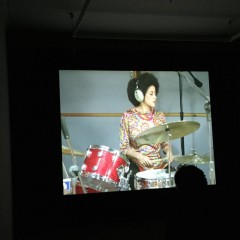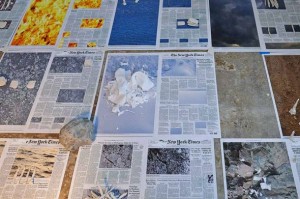On this year’s trip to Miami I took it easy, concentrating on the main event, Art Basel Miami Beach (ABMB), and ignoring 16 other fairs and endless installations, events, museum exhibitions, private collections, a video lounge, film showings, …. In about six hours spread over two days I saw perhaps a third of it, so this is a limited view of a limited view. Missed the opening and associated events, but on Friday and Saturday I still managed to site John Baldessari and the Metropolitan Museum of Art’s director, Thomas Campbell; I thought it brave for a scholar of Renaissance and Baroque tapestries to venture into contemporary art commerce at its most frenzied. I also saw several colleagues I knew, including Lowery Sims, Mark Rosenthal, Jonathan Fineberg and Robert Hobbs.
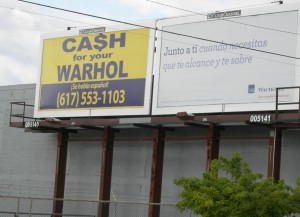
The fair was less crowded than previously, which was not true of Miami highways, which get worse and worse. Jack Pierson‘s MONEY (2009), hanging along one of the main corridors courtesy of Galleria Christian Stein, Milan, was attracting no notice at all, but a friend who’s a dealer said sales had been good. The crowds aren’t the customers.
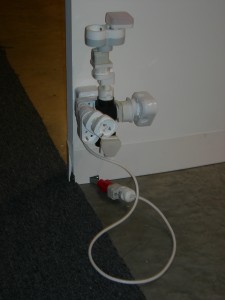
I found myself noticing pieces made with a light touch. I’d liked Philippe Parreno‘s small adapter pieces at IMMA, Dublin (and remarked about them), and while less jarring than in a museum setting, the piece at Esther Schipper, Berlin was pleasantly self-effacing. Someone from the gallery told me it was intended to last as long as the night light at the top; priced at $4,000 that’s a modest artwork, but one expensive night light! Don’t know why the light couldn’t be replaced.
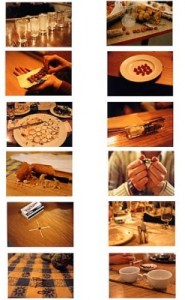
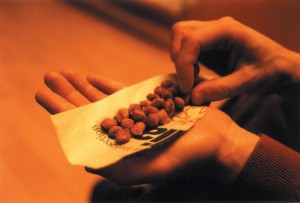
Rivanne Neuenschwander‘s wall-sized Conversation (at Tanya Bonakdar), while large, had a comforting quality of Gemütlichkeit. I found myself imagining a dinner party, hosted by Neuenschwander, with a guest list of Fischli and Weiss, Miralda, Gabriel Orozco, Martha Schwartz, William Wegman, and other artists who play with their food. In the corner of a closet-sized space, also at Bonakdar, was a piece by Sara Sze on an entirely different scale from the work of hers I’d seen: a chicken’s egg rested on the floor and on top of it, a roll of quarters, on top of which was a carpenter’s tape-measure with the tape extending up some five feet, on top of which rested a small bird’s nest which had polychrome skewers worked into it. A string hung from the nest which ended with a tiny noose, just above the floor; I thought of a small bird setting a trap for its dinner. It was light as air, but wonderfully poetic and suggestive.
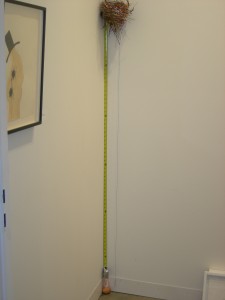
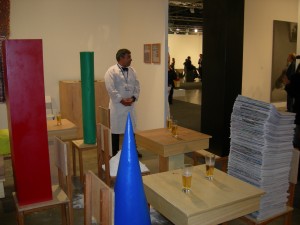
I spent some time in the area called Art Nova, described by the organizers as 50 emerging and established galleries from 17 countries … presenting new works by two or three artists…. providing visitors an opportunity to see pieces fresh from studios around the globe; some were galleries that I remembered seeing previous years at the various peripheral fairs. One of these was A Gentil Carioca (Rio de Janeiro), which was showing Laura Lima’s cafe installation with tables for two, whose patrons consisted of various abstract forms: a blue cone shared a beer with a large stack of newspapers, at the next table were a pile of flour and a black plinth, and behind them a green tube sat with a crumpled yellow ball of paper. Something was going on, but the viewers had to provide the dialog. A uniformed waiter stood at the back; he was solicitous, but apologized that he spoke only Portuguese and Spanish, so I didn’t get further information on Lima or her work.
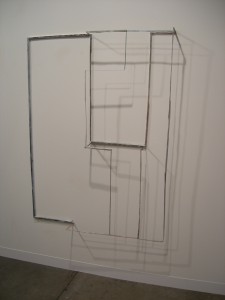
I always enjoy the galleries from cities off the beaten path, as I’m unlikely to get to Reykjavik, Krakow, Seoul or Bangalore. This year two were from Glasgow: Mary, Mary was showing Sarah Barker‘s work; I especially liked a wall piece: an aluminum structure with an irregularly-painted surface, like a floating drawing that interacted with its own shadow. I asked the proprietor (Mary, I presume) whether Glasgow had collectors of contemporary art. She confirmed what I’d heard from other gallerists operating in the periphery: most sales are from fairs, or in this case, from collectors up from London.
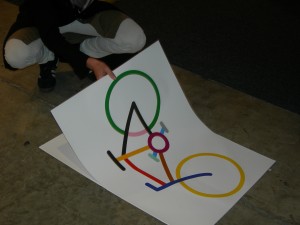
The other Glasgow dealer, The Modern Institute, was doing a brisk business in free prints by Jeremy Deller which lay in the floor for the taking (a la Felix Gonzalez-Torres, but not in a stack – or perhaps I arrived too late to see it). They claimed to have a clientele in Glasgow, but then they show a number of artists with international reputations, including Jim Lambie, Martin Boyce, Urs Fischer and Luke Fowler.
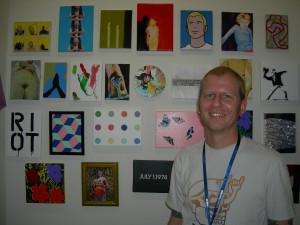
In the area where the magazines had booths I ran into Eric Doeringer, whose work I’d seen two years ago at Geisai, the juried exhibition founded by Takashi Murakami intended to introduce gallery-less artists to an international audience. Doeringer copies well-known works and peddles them in Chelsea and at various art fairs. I asked him to situate his work in relation to other copyists, Sturtevant and Pettibone (something any schooled artist can do these days) and he said his own work was more about commerce and situations where art is sold. He showed me a recent project which might be termed second editions: re-shot versions of early Ruscha books, so the cars are current vintage and the trees have grown (or fallen down). I was amused by his conceptual up-date of a conceptual project.
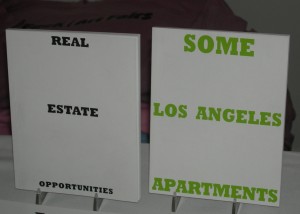
The fair organizers provided information on a free, down-loadable app (at www.artbasel.com/apps) which included an interactive 3-d map, allowing virtual navigation of the exhibition and videos of various public Conversations and events, such as the Oceanfront Nights organized by Creative Time (too late for me). I’m afraid I’m too low-tech to give a personal report on how it functioned.



